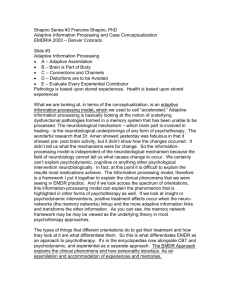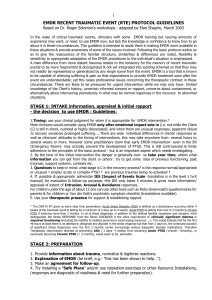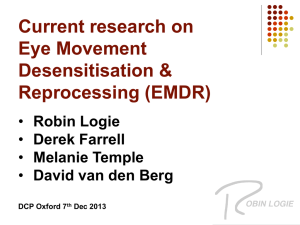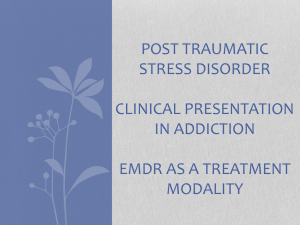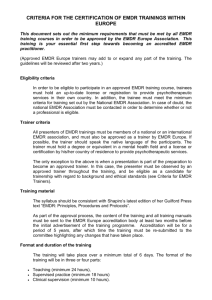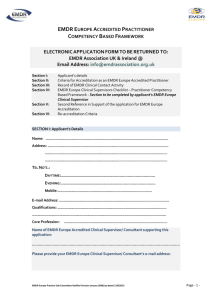the need to strengthen the mindfulness component of emdr
advertisement
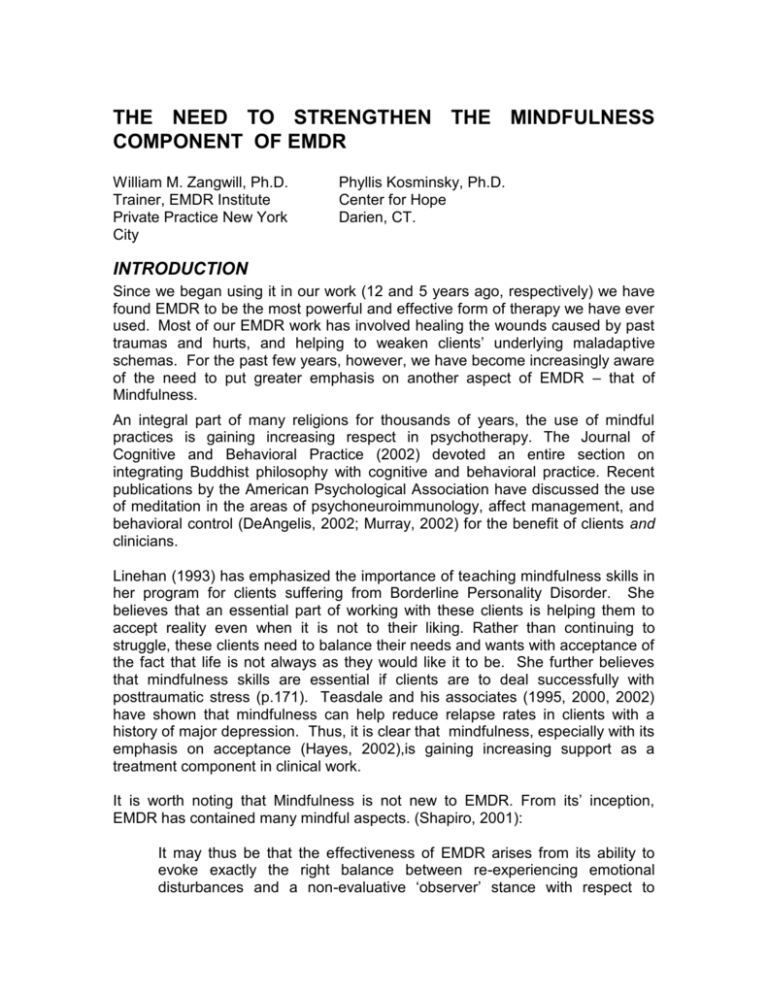
THE NEED TO STRENGTHEN THE MINDFULNESS COMPONENT OF EMDR William M. Zangwill, Ph.D. Trainer, EMDR Institute Private Practice New York City Phyllis Kosminsky, Ph.D. Center for Hope Darien, CT. INTRODUCTION Since we began using it in our work (12 and 5 years ago, respectively) we have found EMDR to be the most powerful and effective form of therapy we have ever used. Most of our EMDR work has involved healing the wounds caused by past traumas and hurts, and helping to weaken clients’ underlying maladaptive schemas. For the past few years, however, we have become increasingly aware of the need to put greater emphasis on another aspect of EMDR – that of Mindfulness. An integral part of many religions for thousands of years, the use of mindful practices is gaining increasing respect in psychotherapy. The Journal of Cognitive and Behavioral Practice (2002) devoted an entire section on integrating Buddhist philosophy with cognitive and behavioral practice. Recent publications by the American Psychological Association have discussed the use of meditation in the areas of psychoneuroimmunology, affect management, and behavioral control (DeAngelis, 2002; Murray, 2002) for the benefit of clients and clinicians. Linehan (1993) has emphasized the importance of teaching mindfulness skills in her program for clients suffering from Borderline Personality Disorder. She believes that an essential part of working with these clients is helping them to accept reality even when it is not to their liking. Rather than continuing to struggle, these clients need to balance their needs and wants with acceptance of the fact that life is not always as they would like it to be. She further believes that mindfulness skills are essential if clients are to deal successfully with posttraumatic stress (p.171). Teasdale and his associates (1995, 2000, 2002) have shown that mindfulness can help reduce relapse rates in clients with a history of major depression. Thus, it is clear that mindfulness, especially with its emphasis on acceptance (Hayes, 2002),is gaining increasing support as a treatment component in clinical work. It is worth noting that Mindfulness is not new to EMDR. From its’ inception, EMDR has contained many mindful aspects. (Shapiro, 2001): It may thus be that the effectiveness of EMDR arises from its ability to evoke exactly the right balance between re-experiencing emotional disturbances and a non-evaluative ‘observer’ stance with respect to emotion and to the flow of somatic, affective, cognitive and sensory associations that arise when this observer stance is maintained continuously for 30 seconds, or minutes at a time, without interruptions from the therapist or from an excessive level of arousal. It may be that eye-movements or other forms of stimuli draw the client’s attention away from the disturbing material just enough to simultaneously prevent “Mindless Emoting” and excessive “Conceptualizing/Doing,” and thus almost force the client into a “Mindful Experiencing” mode of processing of the disturbing material. Each EMDR session would thus consist of repeated and frequent experiences of this mode of processing, guided by the therapist’s control of the session’s flow, and facilitated by the sensory stimulation applied with each “set.” (p. 233). While Mindfulness may be an important component of active processing, what has been missing, we believe, is a more complete appreciation of how mindful practices can enhance our EMDR work in a variety of other areas. The purpose of this paper is to show how that can be done both during and between sessions. MINDFULNESS DURING SESSIONS “When Terry arrived, she looked harried beyond belief. Her child’s school had called, she was overwhelmed at work, and it had taken her 20 minutes to find a parking place. After we said hello, I (first author) invited her to take just a few minutes and do nothing but breathe. Within seconds you could see her visibly start to relax. Within a few minutes, she was ready to begin. “ When clients first arrive, many could benefit from a transitional process that takes them from their often hectic outside world to the, hopefully, intimate, more focused world of a session. To help accomplish this transition, at the beginning of a session, we will often suggest that we just take a few moments to focus on our breath. This simple process often has powerful calming effects. Another benefit of encouraging mindfulness at the beginning of a session is that it allows for enhanced accessing of problematic material (Lipke, 2000). During our initial breathing, we will often encourage clients to “just let whatever needs work to come up, without judging.” Alternatively, we have suggested to clients that while taking slow, deep breaths that they, “scan their body and notice what part of it needs attention, needs to be held with loving kindness.” We have been repeatedly impressed with how spending as little as two to five minutes at the beginning of a session simply focusing on our breath, which we do along with our clients, can help clients (and us!) relax and become more aware of the work that needs to be done. Both in individual sessions and in the training we do for EMDR clinicians, combining mindful practices with EMDR has often led to greatly enhanced processing. We have also found that mindful practices are just as useful at the end of a session as at the beginning. At the beginning of a session we are looking to open a client up; we are not usually concerned if disturbing material arises because we know we will have time to work on it during the session. At the end of a session, however, we want to close things down so as to enable the client to reenter the world as comfortably as possible. Thus, at the beginning of a session, very little instruction is given with whatever mindful practice we are using. At the end, however, we use much more of an active, guided approach. Giving more direction and focusing the client on various images or thoughts helps slow the client’s processing and lessens the chances that disturbing material will arise. BETWEEN SESSIONS Jason had entered treatment because of general feelings of anxiety and defectiveness. He had responded well to EMDR and was functioning much better in many areas of his life. However, he reported continuing anxiety about becoming anxious – especially late at night. He would lie in bed and start to worry that he might get anxious, which would mean that he wouldn’t be able to sleep, which would then mean that he wouldn’t do well at work the next day, which would then lead to….Naturally, all of this worry often did interfere with his sleep, which then led to… Exploration of this issue with EMDR revealed no significant trauma history related to this problem. After trying a number of behavioral techniques, the first author finally gave Jason the assignment to attend a meditation class. Soon, he reported feeling much less anxious. This wasn’t because he never worried about being anxious. It was because when he did feel anxious, he could both better accept the fact that this would happen periodically and use the meditative practices he had learned to cope more successfully. He was now able to separate himself from the anxiety and accept it as something that occurred – not as who he was. Sometimes, he reported that he was even able to laugh at himself and his anxiety. The previous case illustrates an important tenet of EMDR training – helping the client function more adaptively and less reactively in between as well as during sessions. Lately, this concept of resilience – of preparing clients to survive future assaults - has received increasing emphasis (Newman, 2002). The need for increased resilience appear to be directly related to events such as the destruction of the World Trade Center, the recurring threats of biological warfare, and the sniper attacks. Maureen Dowd, columnist for the New York Times, has eloquently stated the effects the events have had on us: Americans, once insulated, and carefree, are not used to being the hunted. Since 9/11 they have struggled with looking over their shoulders at unseen predators, with weapons both invisible and catastrophic, waiting for the next strike that the government assures us is coming (p. A23). We believe that the struggle Dowd describes has created a background level of anxiety that many clients fear can break through at any moment. The theme which emerged most often in our work with Trade Center clients was the fear that they wouldn't be able to cope the next time some horrible event occurred. This sense of impaired resilience is a typical post trauma reaction. But the events of September, 2001, and its’ extended aftermath, have created shock waves which were felt by many more than those directly effected. It has tapped into a deep place in many of our clients' psyches - the place that holds our awareness of how fragile life really is. We all know, yet generally deny or ignore, the deep truth of our lack of control over the most important aspects of our lives. We cannot guarantee that the people we love will love us in return. We cannot insure that our loved ones will remain healthy or alive. We cannot be sure of our own vitality or safety. We are perpetually walking on thin ice, never knowing when or where a break will occur. If we pretend that nothing bad is going to happen, all we guarantee is that we won't be prepared when it does. We know this, but admitting it and dealing it with it is hard. Yet we have it in us to become stronger, and that's really the message we need to bring to our clients. One of the best ways to communicate this message is by helping clients confront old demons, master old fears, and realize that although life has hurt them in the past, they have survived, and can survive future hurts as well. We all need to learn to better accept that life will contain pain, but we can be comforted by the knowledge that we can find in ourselves, and with the help and support of others, the ability to get through the pain and come out on the other side stronger and more resilient instead of weakened and more afraid. We believe that this is the most important message we can impart, and making it a reality the most important work we can do. Given the fact that life will continue to present our clients with stresses and pressures, we think that there is an increased need to make sure our clients have sufficient coping skills to handle the next assault – whether it occurs on an individual or societal level. A fundamental principle of EMDR is that reprocessing prior traumas promotes a deep healing which can strengthen our clients. Using the Float Forward (Browning, 1999) and Future Template techniques, we can help clients to identify and cope with unspecified future fears. But no method or set of techniques can inoculate us against the myriad trials of human life. By combining mindfulness techniques with EMDR, we can encourage our clients to move into a place of deeper peace, awareness, and healing. For further information or reprints please contact: William M. Zangwill, Ph.D. 124 W. 93rd St.#9F NY, NY 10025 (212) 663-2989 Tel. Wzangwill@aol.com Website: EMDRandMeditation.com REFERENCES Browning, C..J. (1999). “Floatback and Float-Forward: Techniques for Linking Past, Present and Future”. EMDRIA Newsletter. September, 1999, p. 12. DeAngelis, T. (2002). A Bright Future for PNI. Monitor on Psychology. July. p. 46-53. Dowd, M. (2002). Black and White., The New York Times. , Oct. 16, 2002, p. A23. Hayes, S. (2002). Buddhism and Acceptance and Commitment Therapy. p. 5866. Journal of Cognitive and Behavioral Practice. (2002). Special Series - Integrating Buddhist Philosophy with Cognitive and Behavioral Practice. 9, 1, Various articles from p. 38 – 78. Lipke, H. (2000) EMDR and Psychotherapy Integration. CRC Press, Florida. Murray, B. Finding the Peace within Us. Monitor on Psychology. July/August. P. 36. Shapiro, F. (2001). Eye Movement Desensitization and Reprocessing: Basic Principles, Protocols and Procedures. 2nd Ed. Guilford Press, New York. Teasdale, J.D., Moore, R.G., Hayhurst, H., Pope, M., Williams, W & Z.V. (2002). Metacognitive awareness and prevention of relapse depression: Empirical evidence. Journal of Consulting and Psychology, 70, 2, 275-287. Teasdale, J.D., Segal, Z.V., & Williams, J.M.G. (1995). How does Segal, in Clinical cognitive therapy prevent relapse and why should attentional control (mindfulness) training help? Behaviour Research and Therapy, 33, 25-39. Teasdale, J.D., Segal, Z.V., Williams, J.M.G., Ridgeway, V.A., Soulsby, J.M., & Lau, M.A. (2000). Prevention of relapse/recurrence in major depression by mindfulness-based cognitive therapy. Journal of Consulting and Clinical Psychology. 68, 4, 615-623.

